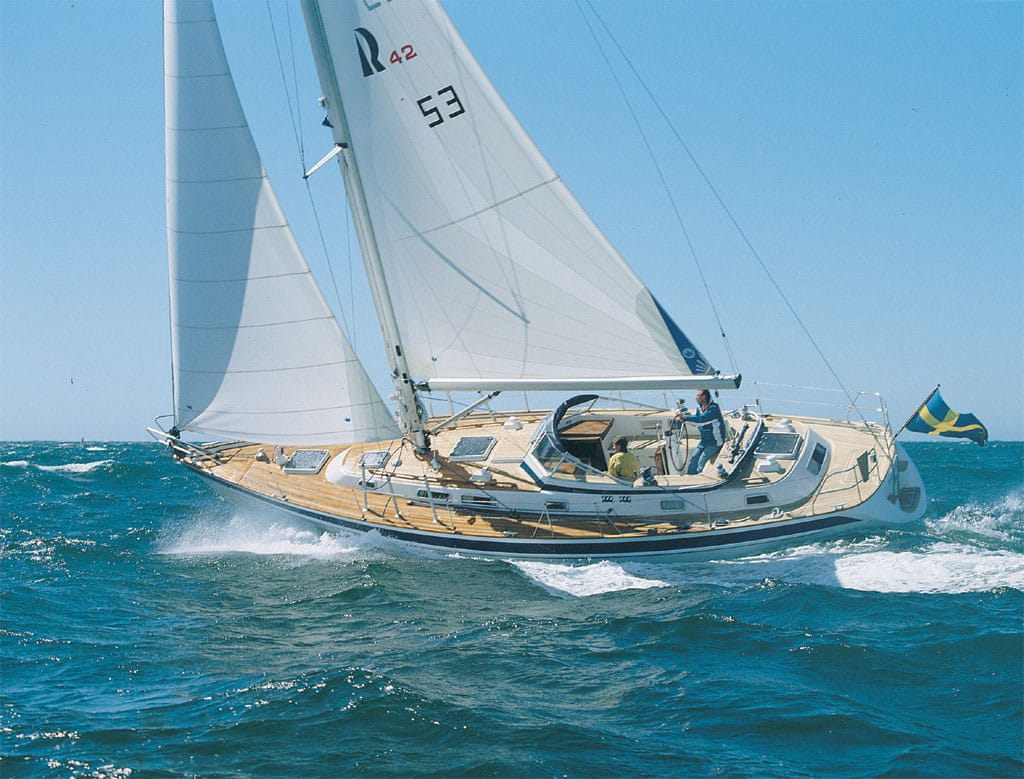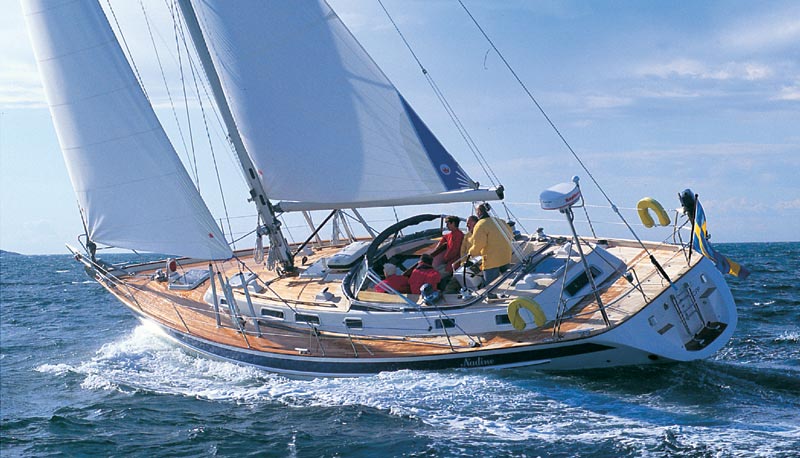
These substantial cruising vessels from the Swedish builder Hallberg-Rassy are great boats. German Frers has produced handsome, contemporary designs without faddish extremes of style, vessels that will look good 20 years from now. The figures imply a generally conservative design that is well suited to offshore sailing and will perform well in a variety of conditions. Supplied polar diagrams indicate good speeds; for example, in a 14-knot breeze the 42 points up to well under 45 degrees and achieves a healthy 6.6 knots, while the 46 points slightly under 45 degrees and makes 6.9 knots. The HRs power well, turn in their own length and steer positively in reverse.
Hand laid up using isophthalic resin, HRs feature a complete grid system below the sole for the hull stiffening. They also are Lloyds inspected during construction, and a certificate is issued with each boat. The hulls are insulated with PVC foam above the waterline and fitted with Webasto cabin heaters (two in the 46) so that their owners will be warm and comfortable below even in adverse conditions. (Hey, they’re built in Sweden!) In tropical climes ample ventilation is provided by dorade vents, numerous opening ports, four to five opening hatches and saucer-type electric vents. No sweat!
Attention to detail appears in every corner and much thought has been given to ease of maintenance, from the roomy, well-laid-out engine rooms to the ball-bearing-supported rudders with handy emergency tillers. The 42 has the generally accepted cable steering setup, but the 46, I was pleased to see, was fitted with an almost bulletproof rack-and-pinion system. Bronze seacocks are fitted to all thru-hulls, and care has been taken to ensure quick and easy access. The electrical system of the 42 is fairly standard 12-volt DC with individual engine-starting and shipÕs-power batteries. The 46 has 12-volt DC engine starting but features a separate 24-volt DC shipÕs-power system with 55-amp alternator; the 290-amp 24-volt batteries guarantees more than adequate electricity for normal usage.
Adding to sailing comfort is the optional hard dodger. I did find that the one on the 46 made it difficult (for a Falstaffian 64-year-old) to get quickly from the deck to the companionway, as the space between the aft end of the dodger and the pedestal is a bit close. The dodger on the 42 has a cutout in the middle (closeable with a neat canvas cover) that eliminates this problem. The teak decks are clean and wide; large lockers provide the space necessary to store the junk we all carry. I was able to stuff six large fenders into the bow locker of the 42, which is separated from the cabin by a ply divider. The bow locker on the 46 is even bigger! Aft, the 46 has a huge lazarette, the 42 a shallower one. Both boats provide a good-sized cockpit locker plus a gas-bottle locker on the starboard deck.
HR 42 Specs
LOA: 43’4″ (13.22 m.)
LWL: 39’3″ (11.96 m.)
Beam: 12’10” (3.95 m.)
Draft (deep): 6’6″ (2.0 m.)
Ballast: 10,528 lbs. (4,775 kgs.)
Disp: 28,000 lbs. (12,700 kgs.)
Sail area: (100%) 958 sq.ft. (89 sq.m.)
Mast above water: 61’6″ (18.74 m.)
Ballast/Disp: .37
Disp/Length: 206
SA/Disp: 16.6
Fuel: 110 gal. (416 l.)
Water: 180 gal. (681 l.)
Auxiliary: Volvo Penta 76 hp.
Designer: German Frers
Base price: $319,900

Both the 46 and 42 feature beautifully finished mahogany interiors, full carpeting (easily removable for cleaning) over teak-and-holly soles, curtains on the windows and hatches (a very nice touch at night), and first-class upholstery. The arrangements of the two boats were quite similar, with the 46 gaining an extra cabin forward of the saloon by reason of its greater length, plus a bit of elbow room from the added beam using numerous lockers, compartments and drawers. The designer has provided the stowage space needed for extended voyaging.
I was impressed with the 42’s saloon as it had the optional layout with the very plush easy chairs on the starboard side. I also preferred the 42’s aft cabin as it had a comfortable settee on the port side in place of the extra berth of the 46. This is a personal preference, of course: If you need the extra berth space, then the chairs and/or the settee have to go.
The completely equipped galley is laid out with a gimballed stove, stove safety-rail, deep double sink, backup hand-pump and very generous storage. The stove is fitted so that it will swing to a steep angle on either tack. A moderate-size electric refrigerator is located abaft the chart table. About the only complaint is that the refrigerator might be a bit difficult to access if there were potentially scalding pots on the stove, but the cook will be able to work around this with experience. Simply get the cold stuff out before you put the hot stuff on!
A workable sit-down chart table with space for all the necessary instrumentation is on the port side; the readily accessible electric panel is located outboard of it. Again there is good storage, and it is easy to see that the designer and builders know what the cruising sailor requires in the way of stowage space.
The aft heads in both boats are virtually identical and feature a great stall shower with seat. The forward head in the 46 also has a stall shower while the 42’s head, though spacious, has the more typical arrangement, with the shower sharing the w.c. space. The roomy heads are all white fiberglass and formica so will be easy to clean and keep clean. Again, they offer generous storage in a multitude of lockers.
Now, just a few criticisms of these otherwise fine boats: First, I don’t care for deck-stepped masts on a bluewater cruiser. They are not as strong as a keel-stepped mast. To offset this, the designer has to specify a stronger, heavier tube. Also, if and when something fails, the whole kit and kaboodle goes over the side, making it very difficult to set up a jury rig.
Second, I donÕt like to see stainless steel bolts in a lead-ballast fin. Stainless steel is subject to crevice corrosion in damp, oxygen-deprived conditions, and it is a less noble metal than the lead so is open to galvanic corrosion. For these reasons, bronze bolts are preferable. Stainless steel tanks also worry me for the potential of pinhole leaks due to crevice corrosion. Having said this, I must admit that thousands of boats with deck-stepped masts have made extensive voyages with no problems (and no deck leaks); their stainless steel-fastened lead ballast keels are still hanging in there; and their stainless tanks are still holding liquid.
HR 46 Specs
LOA: 48’5″ (14.78 m.)
LWL: 43’5″ (13.27 m.)
Beam: 14’3″ (4.27 m.)
Draft (deep): 6’2″ (1.88 m.)
Ballast: 14,336 lbs. (6,502 kgs.)
Disp: 35,840 lbs. (16,256 kgs.)
Sail area: (100%) 1,076 sq.ft. (100 sq.m.)
Mast above water: 63’8″ (19.4 m.)
Ballast/Disp: .40
Disp/Length: 193
SA/Disp: 15.8
Fuel: 124 gal. (658 l.)
Water: 243 gal. (919 l.)
Auxiliary: Volvo Penta 95 hp.
Designer: German Frers
Base price: $438,000
In sum, these Hallberg-Rassys, both the 42 and the 46, are truly first-class cruising sailboats in every respect, from the initial design to the last coat of varnish. I have no hesitation in recommending them to anyone looking for a fine family cruiser or a strong circumnavigator. These are boats that will take you out and bring you back, in safety, style and comfort.
Hallberg-Rassy (Free State Yachts)
64 Old South River Rd.
Edgewater, MD 21037
Phone (410) 266-9060








